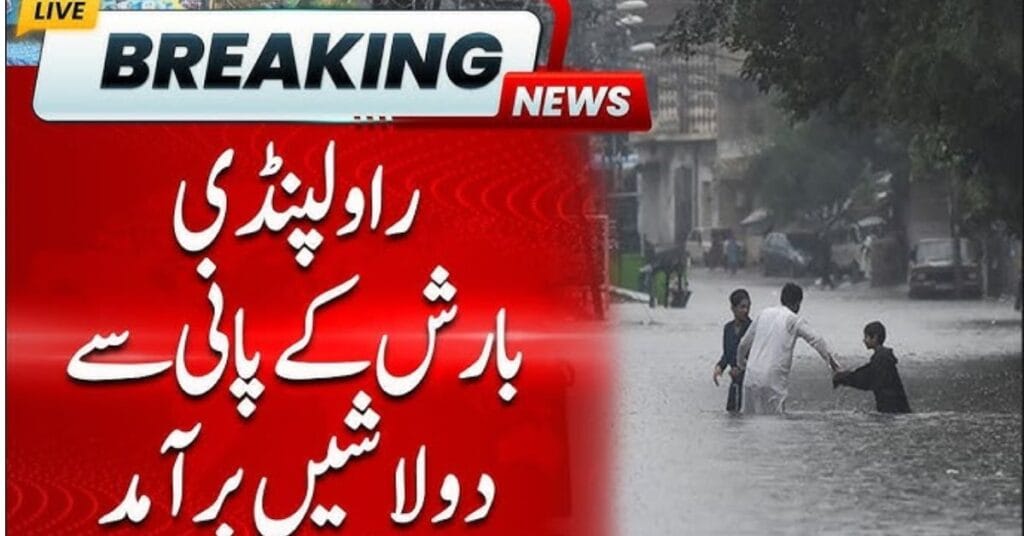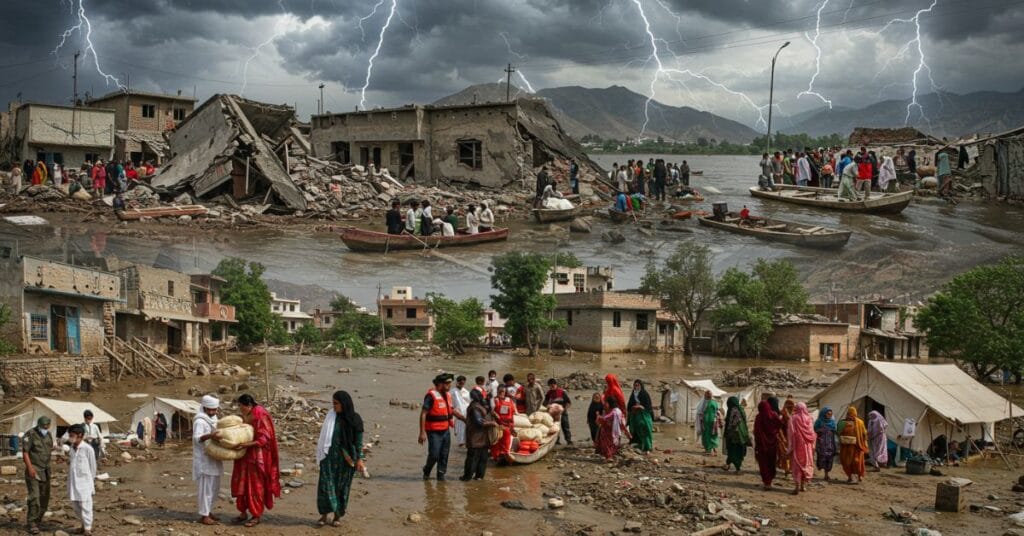Monsoon Rain 2025 Hits Pakistan: Cities on High Alert
July 2025 has ushered in one of the most devastating monsoon seasons Pakistan has faced in recent memory. With unprecedented downpours hammering Karachi, Lahore, Islamabad, and several other major cities, authorities have declared a state of emergency due to flooding. Roads are submerged, flights are delayed, schools are closed, and citizens are left grappling with the fallout from monsoon rain in 2025.
This article brings you real-time updates, regional breakdowns, and actionable safety tips. Based on verified reports and 2025 climate data, this is your essential guide to surviving the 2025 monsoon.
As monsoon rain 2025 continues to disrupt daily life, it’s crucial to stay informed and prepared for further impacts across the nation.
Pakistan National Emergency Alert
Monsoon Disaster | June 26 – July 17, 2025
78 Dead | 491 Injured | Thousands Displaced
Pakistan is reeling from the devastating effects of severe monsoon rains that have swept across the nation between June 26 and July 17, 2025.
The intensity of monsoon rain in 2025 has overwhelmed many areas, emphasizing the need for better infrastructure and emergency response.
Major urban centers — Lahore, Islamabad, Peshawar, and Quetta — have been battered by relentless rainfall, triggering flash floods and infrastructure failures. Rural regions, plagued by poor drainage systems and collapsed roads, are suffering even worse.
“This is no longer just a seasonal pattern — it’s a national emergency rooted in climate chaos,” warn experts.
Emergency Response Underway
The NDMA, with help from local governments, is leading large-scale rescue operations. Despite efforts, thousands remain stranded without shelter, clean water, or medical support.

🕯️ National Mourning
Pakistan mourns the 178 lives lost. Entire families have been uprooted. The tragedy demands not only aid but long-term climate resilience planning, urban reform, and early warning systems.
Pakistan’s Monsoon Season Turns Dangerous
Sudden Downpours Across the Country
Heavy rainfall in Pakistan has intensified this week, with over 200mm recorded in Karachi and Lahore within a 48-hour window. In Islamabad, cloudbursts in the Margalla Hills region triggered flash floods, inundating low-lying sectors.
According to the Pakistan Meteorological Department (PMD), this surge in rainfall is part of a wider pattern seen across South Asia, signaling an intensification of the monsoon due to climate anomalies.
2025 Rain Pattern vs Previous Years
Compared to Monsoon 2023 and 2024, 2025 has seen a 38% increase in rain volume across urban centers. Unlike past years where rainfall was distributed evenly over July and August, 2025 is exhibiting “burst phases” — intense rain over short durations.
NDMA and PDMA Updates
The National Disaster Management Authority (NDMA) and Provincial Disaster Management Authorities (PDMAs) have issued red alerts for Sindh and Punjab. NDMA confirms deployment of rescue teams in 18 districts. Citizens are advised to avoid unnecessary travel.
As per PDMA Punjab (July 18, 2025):
- Over 3,000 people rescued from flooded areas in Lahore
- Emergency declared in 6 tehsils
- Power supply suspended in flood-prone neighborhoods
City-Wise Rain Update: Karachi, Lahore, Islamabad & More
With each passing day, the effects of monsoon rain in 2025 become more evident, posing challenges for local governments and citizens.
The ongoing monsoon rain in 2025 has led to widespread power outages and disrupted essential services.
Karachi: Urban Flooding and Power Outages
Karachi is once again grappling with monsoon chaos. Over 220mm of rain flooded major roads like the Shahrah-e-Faisal and the Korangi Expressway. K-Electric reported power shutdowns in over 400 feeders. Citizens shared videos of submerged cars and collapsed walls in Gulshan and Defence areas.
Lahore: Drainage Collapse in Low-Lying Areas
Impact of Monsoon Rain 2025 on Urban Areas
In Lahore, Ravi Road, Ferozepur Road, and Johar Town are seeing waist-deep water. The Lahore Waste Management Company (LWMC) has failed to drain key roads despite pre-monsoon preparation claims.
The challenges of urban flooding highlighted by monsoon rain in 2025 require urgent attention and action.
Islamabad: Margalla Hills Spark Flash Floods
A sudden 140mm downpour triggered landslides near Pir Sohawa and flash floods in E-11, G-10, and F-7. Rescue 1122 confirmed 8 minor injuries due to collapsed boundary walls.
ChatGPT said:
Rawalpindi Monsoon Emergency Update – July 19, 2025
Rawalpindi is facing critical challenges as continuous monsoon rainfall has led to urban flooding, road blockages, and disruption of daily life. Within the last 24 hours, several low-lying areas such as Dhok Kala Khan, Sadiqabad, and Shamsabad have been inundated, with water entering homes and shops. Rawalpindi’s drainage system, already strained under pressure, has failed to cope with the volume of rainwater, triggering emergency response alerts from the city administration and rescue teams.
Local authorities, including the Water and Sanitation Agency (WASA), are working around the clock to pump out stagnant water, but residents continue to suffer due to traffic gridlocks, power outages, and limited access to clean drinking water. Rescue 1122 has deployed boats in severely affected colonies, while the Rawalpindi Municipal Corporation has urged citizens to stay indoors unless necessary. The threat of waterborne diseases, electrical hazards, and further rainfall has made the situation even more dangerous.
Weather officials warn that more heavy rain spells are expected in the coming days. Citizens are advised to monitor NDMA alerts, avoid open manholes and electric poles, and report emergencies immediately. Rawalpindi stands at a critical juncture — the city’s infrastructure is under stress, and without long-term investment in drainage and disaster planning, such scenes may repeat with greater intensity.

Chakwal Monsoon Disaster Update – July 19, 2025
The situation in Chakwal remains grim following intense overnight rainfall that caused widespread flash floods across the district. A sudden cloudburst led to over 400mm of rain within just 10 hours, overwhelming the city’s natural drainage and flooding residential areas, agricultural lands, and main roads.
Entire localities in Balkassar, Talagang, and Choa Saidan Shah have been submerged, with reports of collapsed homes, livestock swept away, and residents trapped on rooftops. The Provincial Disaster Management Authority (PDMA) has confirmed multiple casualties and dozens of injuries, though exact figures are still emerging. Emergency teams from Rescue 1122, civil defense, and the district administration are carrying out round-the-clock rescue and relief efforts, but access to remote villages remains severely restricted due to blocked or washed-away roads.
In light of the disruptions caused by monsoon rain in 2025, it’s important to prioritize future disaster management planning.
Chakwal’s hilly terrain, already vulnerable to landslides, is experiencing further instability, posing risks of rockfall and mudslides. The local government has declared a red alert, urging people to stay indoors and relocate from flood-prone zones where possible. Power supply in many union councils has been suspended to prevent electrocution incidents.
This tragedy has once again exposed the fragility of rural infrastructure and the urgent need for preemptive climate adaptation policies in Pakistan’s smaller districts. For now, Chakwal needs immediate help in the form of food supplies, shelter tents, clean water, and medical assistance.
Other Affected Cities:
- Peshawar: 75mm of rain flooded the GT Road and University Town
- Quetta: Roof collapses reported in the Sariab Road area
- Sialkot: Rainwater entered over 300 homes
Monsoon Emergency 2025: Punjab, Sindh, KPK & Balochistan Grapple with Deadly Rainfall
Heavy Rain, Urban Flooding, and Rural Collapse – Latest Updates from Across Pakistan
Unrelenting Monsoon Rainfall Turns Deadly Across Pakistan
From Lahore to Karachi, and from Swat to Gwadar, monsoon 2025 has unleashed widespread damage across Punjab, Sindh, Khyber Pakhtunkhwa (KPK), and Balochistan. With over 178 lives lost and thousands displaced, Pakistan is now under a national emergency response mode.
The damage caused by monsoon rain in 2025 has raised questions about urban planning and disaster preparedness in Pakistan.
Every citizen’s role in addressing the challenges of monsoon rain in 2025 is vital for collective progress.
The widespread disruptions from monsoon rain in 2025 serve as a wake-up call for policymakers and citizens alike.
The National Disaster Management Authority (NDMA) has issued high-alert warnings in all four provinces, urging citizens to remain cautious as more rainfall is forecasted in the coming days.
Punjab: Flooded Streets, Collapsing Infrastructure
As authorities struggle to respond to the crisis, the long-term implications of monsoon rain in 2025 are becoming a focal point for discussions on climate resilience.
Understanding the patterns of monsoon rain in 2025 is essential for developing effective intervention strategies for future seasons.
The rising severity of monsoon rain in 2025 urges a reevaluation of current disaster management systems to mitigate risks.
As we assess the impact of monsoon rain in 2025, community resilience will be a key factor for future preparedness.
In light of the challenges posed by monsoon rain in 2025, community involvement will be vital for recovery efforts.
As we navigate the aftermath of monsoon rain in 2025, the call for sustainable development practices grows louder.
Punjab has been among the hardest-hit provinces. Lahore, Rawalpindi, Chakwal, and Multan have reported record-breaking rain with severe urban flooding.
Low-lying neighborhoods are underwater, electricity outages are widespread, and emergency workers are using boats to rescue families stranded in flooded homes. The Punjab Disaster Management Authority (PDMA) has activated emergency centers, but rural areas with weak drainage remain at high risk.
“This is not just rain — it’s a collapse of systems we failed to strengthen,” said a PDMA spokesperson.
Sindh: Karachi and Interior Towns Drowning in Monsoon Chaos
Karachi is once again the face of poor rain preparedness. Streets in Malir, Korangi, Saddar, and North Nazimabad are submerged, with blocked sewer lines adding to the crisis. Hyderabad, Sukkur, and Larkana face similar threats as rural communities report damage to homes and crops.
Sindh’s agriculture sector is under pressure, with standing water in fields raising fears of pest outbreaks and food supply disruption.
Despite claims of “monsoon readiness,” the Sindh government’s response has been slow, and public frustration is rising.
KPK: Flash Floods and Landslides in Hilly Areas
In Khyber Pakhtunkhwa (KPK), the situation is worsening by the hour. Swat, Nowshera, Mardan, and Mansehra have experienced flash floods, while landslides in mountainous areas have blocked key access roads and cut off several villages.
Local authorities have set up relief camps in schools and community halls, but clean drinking water and medical care remain scarce. The Provincial Disaster Management Authority (PDMA) in KPK is urging immediate support from the federal government.
Balochistan: Washed-Out Roads, No Power, No Aid
Quetta, Zhob, Khuzdar, and Gwadar are facing a silent crisis. Balochistan’s remote villages have been cut off from help, with washed-out roads, collapsed bridges, and mobile signals down.
The future of urban planning must take into account the lessons learned from monsoon rain in 2025.
Rescue operations are severely delayed, and locals are calling for helicopter evacuations and emergency rations. Several homes made of mud bricks have completely collapsed, and the provincial response remains sluggish due to limited resources and extreme terrain.

National Response & Forecast
The NDMA, in coordination with the armed forces, Rescue 1122, and provincial governments, is leading multi-agency relief efforts. Still, gaps in coordination, outdated drainage systems, and a lack of early warning infrastructure have made the impact worse than expected.
The Pakistan Meteorological Department (PMD) has forecast more rain for the next 3 days, especially in Upper Punjab, South Sindh, Northern KPK, and Eastern Balochistan.
“We are witnessing climate intensity beyond our planning,” said a senior official from PMD.
What’s Needed Now: Urgent Relief & Long-Term Reform
This crisis reveals deep-rooted problems in urban planning, disaster readiness, and climate resilience in Pakistan. Immediate needs include:
- Shelter, clean water, and food for displaced families
- Medical teams in rural and remote regions
- Drainage and pumping infrastructure support
- Climate-focused investment in an early warning system
Real-Time Weather Map & Citizen Reports
Live radar maps from PMD show storm bands still hovering over South Punjab and upper Sindh. Citizens are sharing videos under PakistanRain2025, exposing poor infrastructure and government negligence.
Government Response and Emergency Warnings
PMD & NDMA Statements
While dealing with the aftermath of monsoon rain in 2025, community support remains crucial for recovery.
The PMD has forecast continued heavy rainfall for the next 48 hours in Karachi, Lahore, Multan, Bahawalpur, and southern KP. According to their July 19 bulletin:
Education and awareness about the risks of monsoon rain in 2025 are vital for building a resilient society.
Moist currents from the Arabian Sea are intensifying. Thunderstorms are likely to persist with peak activity on July 20.”
NDMA is urging provincial departments to activate urban flood emergency protocols. The Pakistan Army has also been placed on standby for rescue operations.
Ultimately, the lessons learned from monsoon rain 2025 can lead to improved policies and practices for the future.
Red Alert Zones & Emergency Contacts
- Red Alert Areas: Karachi, Lahore, Islamabad, Multan, Bahawalpur, DG Khan
- Rescue Helplines:
- Rescue 1122 (Nationwide)
- NDMA Emergency: 051-111-157-157
- PDMA Sindh: 021-99244593
In conclusion, the resilience of communities affected by monsoon rain in 2025 will depend on collaborative efforts.
Citizens are urged to store drinking water, keep emergency kits, and charge mobile phones.
In conclusion, the challenges brought by monsoon rain in 2025 demand immediate and sustained action from all stakeholders.
As we reflect on the events of monsoon rain 2025, building back better is not just necessary but imperative.
Impact on Daily Life, Schools, Flights & Economy
School Closures
This ongoing situation highlights the importance of strategic planning for the future seasons of monsoon rain in 2025.
Punjab Education Department has closed all government and private schools in Lahore, Faisalabad, and Sialkot till July 22. Sindh Education Ministry may follow suit in Karachi.
Flights & Transport
PIA has delayed over 25 domestic flights. Motorways M-2, M-4, and M-9 are partially closed. Urban traffic is paralyzed in major cities due to submerged underpasses.
Business Disruption
Markets in Saddar (Karachi), Anarkali (Lahore), and Raja Bazaar (Rawalpindi) remained shut. Traders cite losses of over Rs. 8 billion in 3 days.
Why Pakistan’s Rainfall Is Getting Worse
Role of Climate Change
Climate scientists at GCISC confirm that rising sea temperatures are amplifying the monsoon system. Pakistan, with its fragile urban ecosystems, is among the worst hit.
Infrastructure & Urban Planning Failures
Despite budget allocations for stormwater drains and flood defenses, local governments have failed to implement sustainable infrastructure projects.
Lahore, Karachi, and Islamabad have grown unchecked, ignoring natural drainage patterns and overbuilding on floodplains.
How to Stay Safe During the Monsoon 2025
Monsoon Safety Do’s and Don’ts:
- Do stay indoors during rain spells
- Do not unplug electronics during thunderstorms
- Don’t drive on water-covered roads
- Don’t touch electric poles or fallen wires
Flood Survival Tips:
- Keep an emergency bag with essentials
- Move to higher floors if flooding begins
- Stay updated with PMD and NDMA channels
Electricity & Driving Precautions:
- Don’t charge devices near water
- Drive slowly and avoid brakes in deep water
- Keep headlights on in low visibility
Future Rain Predictions: What to Expect Next
PMD 7-Day Forecast
From July 20 to 26, moderate to heavy rain is expected across central Punjab, interior Sindh, and north KP. PMD has advised farmers and travelers to remain cautious.
Disease Alerts
The Ministry of Health warns of potential outbreaks:
- Dengue is due to stagnant water
- Gastroenteritis in flooded zones
- Skin infections and typhoid in relief camps
FAQs
1. How long will the monsoon rain last in Pakistan in 2025?
According to the PMD, active monsoon spells are expected till late August, with peak rainfall in late July.
2. Which cities are most affected by the 2025 monsoon?
Karachi, Lahore, Islamabad, Multan, Sialkot, and Quetta are facing major urban flooding.
3. Is school closed in Lahore and Karachi due to rain?
Yes, schools are officially closed in Lahore. Karachi closures are expected to follow depending on rain intensity.
4. Are flights being cancelled due to monsoon rain?
Many PIA and Airblue flights have been delayed or cancelled due to poor visibility and flooded runways.
5. What is the NDMA’s emergency helpline number?
Call NDMA at 051-111-157-157 or your provincial PDMA.
6. What is the latest monsoon update in Pakistan?
As of July 19, 2025, over 178 people have died and hundreds are injured due to intense rainfall, flash floods, and landslides in all four provinces.
7. Which cities are most affected by the monsoon in 2025?
Lahore, Karachi, Quetta, Swat, Rawalpindi, and Hyderabad are among the most severely affected areas.
8. How can I help flood victims in Pakistan?
Residents affected by monsoon rain in 2025 are encouraged to reach out for assistance and resources during recovery.
You can donate to NDMA-approved charities, support local shelters, or volunteer in verified relief operations.
9. Is more rain expected in the coming days?
Yes, the PMD has issued rain alerts for Upper Punjab, Northern KPK, South Sindh, and parts of Balochistan through the weekend.
10. Why does Pakistan face such severe flooding every year?
Finally, the experiences from monsoon rain 2025 should inform future preparedness and response strategies.
Pakistan lacks modern drainage systems, early warning infrastructure, and urban climate adaptation, making it highly vulnerable during every monsoon.
As we reflect on the widespread impact of monsoon rain in 2025, community engagement will be essential for recovery.











